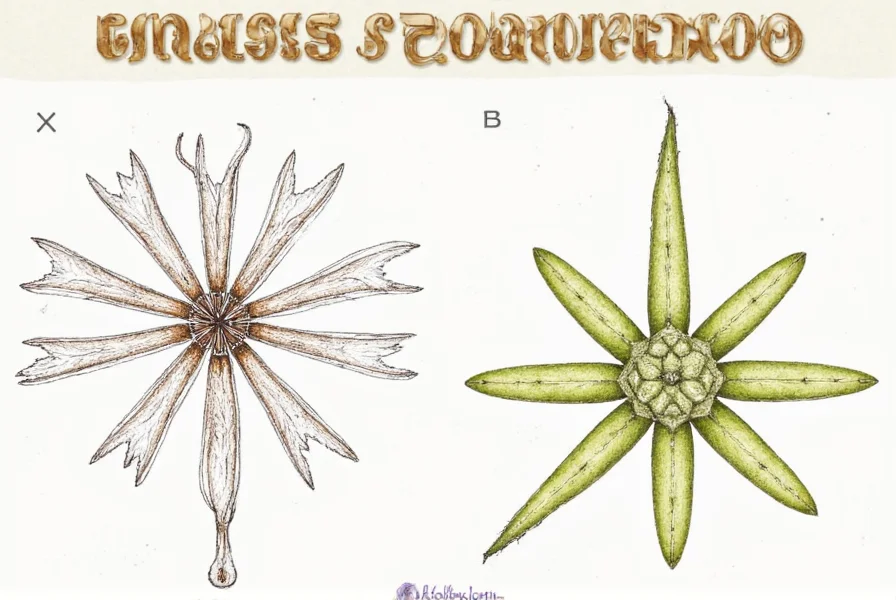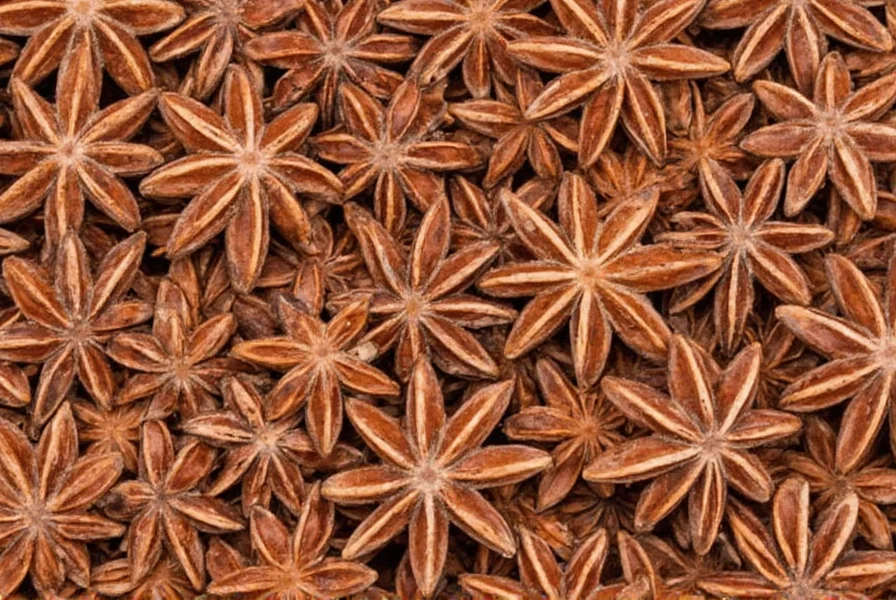Understanding how to properly pronounce culinary terms enhances your cooking experience and communication in kitchen settings. Star anise, that distinctive eight-pointed star-shaped spice frequently used in Asian cuisine and holiday baking, often causes confusion at the cutting board. Let's clarify exactly how to say this term correctly and explore why the pronunciation matters in culinary contexts.
Breaking Down Star Anise Pronunciation
The word "star" is straightforward, pronounced exactly as the celestial body: stahr (with a clear "a" sound as in "car"). The confusion typically arises with "anise."
"Anise" is pronounced AN-ees, with the emphasis on the first syllable and a long "e" sound at the end. It's not "AN-iss" or "uh-NEES." The "s" at the end is definitely not silent, nor does it sound like "zed" as some mistakenly believe.
| Component | Phonetic Spelling | IPA Notation | Common Mispronunciation |
|---|---|---|---|
| Star | stahr | /stɑːr/ | stair |
| Anise | AN-ees | /ˈæn.iːs/ | AN-iss, uh-NEES |
| Star anise | stahr AN-ees | /stɑːr ˈæn.iːs/ | stair ANNIS |
Why Star Anise Pronunciation Matters in Culinary Settings
Correct pronunciation of ingredients serves several practical purposes in cooking environments. When following recipes that call for star anise, particularly in professional kitchens or cooking classes, precise communication prevents confusion with similar spices like regular anise seed (which is pronounced the same but comes from a different plant).
Many home cooks searching for how to pronounce star anise correctly encounter this confusion when watching cooking shows or participating in culinary workshops. The distinction becomes particularly important when discussing recipes that specify both star anise and regular anise seed, as they have different flavor profiles despite the similar names.

Common Mispronunciations and Their Origins
The most frequent error in star anise pronunciation is saying "star ANNIS" (rhyming with "fanny"). This mistake likely stems from several factors:
- Confusion with the word "aniseed" (which is pronounced AN-uh-seed but refers to the same compound)
- Misreading the spelling and assuming the "s" should sound like "z"
- Regional dialect influences where vowel sounds shift
- Association with similar words like "aniseikonia" in medical terminology
Another common error is placing the emphasis on the second syllable (uh-NEES), which changes the word's rhythm completely. The correct stress pattern follows standard English pronunciation rules for this word origin.
Linguistic History Behind the Pronunciation
Understanding the etymology provides clarity for star anise pronunciation guide enthusiasts. The word "anise" comes from the Greek "anison" through Latin "anisum" and Old French "anis." The final "e" in the modern English spelling indicates the long vowel sound, similar to words like "machine" or "premise."
Star anise specifically (Illicium verum) entered English vocabulary later than regular anise (Pimpinella anisum), but adopted the same pronunciation pattern. The "star" descriptor simply refers to its distinctive eight-pointed shape, not to any astronomical connection.
Using Star Anise Correctly in Conversation
When discussing this spice in culinary contexts, proper pronunciation builds credibility. Consider these examples of correct usage:
- "This Vietnamese pho recipe requires one whole star anise (stahr AN-ees) pod."
- "For the mulled wine, add two star anise pieces along with the cinnamon sticks."
- "Be careful not to confuse star anise with Japanese star anise, which is toxic."
Notice how in each case, the term flows naturally with the correct pronunciation. This becomes especially important when giving cooking demonstrations or teaching others, as clear communication prevents recipe errors.

Distinguishing Star Anise from Similar Terms
Many people searching for star anise vs anise pronunciation want to understand if there's a difference. The good news is that both terms use identical pronunciation:
- Star anise: stahr AN-ees
- Anise (seed): AN-ees
- Aniseed: AN-uh-seed (though this refers to the same compound as anise)
The primary difference is that "anise" by itself typically refers to the seed from the anise plant (Pimpinella anisum), while "star anise" comes from a completely different plant (Illicium verum) native to China. Despite coming from different botanical families, both contain anethole, which gives them their characteristic licorice-like flavor.
Regional Variations in Star Anise Pronunciation
While the standard pronunciation remains consistent across most English-speaking regions, some variations exist:
- British English: Sometimes features a slightly more clipped "a" sound in "anise"
- Australian English: May have a flatter vowel sound
- North American English: Generally follows the stahr AN-ees pattern described
These regional differences are minor and shouldn't cause confusion. The key is maintaining the two-syllable structure with emphasis on the first syllable of "anise."
Practical Tips for Remembering the Correct Pronunciation
Here are effective memory aids for mastering the correct way to say star anise:
- Think of the phrase: "The STAR shines on the AN-ees"
- Remember that it rhymes with "carry the fees"
- Break it into syllables: STAR - AN - EES (3 distinct sounds)
- Associate with the similar word "amnesia" which also has the AN-EEZ sound
These techniques help cement the proper pronunciation in your memory for those moments when you're at the grocery store or farmers market asking for this distinctive spice.
Star Anise in Global Cuisine Contexts
When exploring international recipes, you might encounter star anise under different names, but the English pronunciation remains consistent. In Chinese cuisine (where it's called "ba jiao" meaning eight corners), Indian cooking, or Middle Eastern dishes, referring to it as "star anise" with the correct pronunciation ensures clear communication regardless of the culinary tradition.
This is particularly valuable for home cooks following global recipes who want to sound knowledgeable when discussing ingredients. Understanding star anise spice pronunciation becomes part of culinary literacy that enhances your cooking journey.
Frequently Asked Questions
Is star anise pronounced 'star annis' or 'star anees'?
Star anise is correctly pronounced 'stahr AN-ees' (with a long 'e' sound at the end), not 'star annis.' The emphasis is on the second syllable with the 's' clearly pronounced.
What's the difference between star anise and anise seed pronunciation?
Both are pronounced the same: 'AN-ees' for anise seed and 'stahr AN-ees' for star anise. The only difference is the addition of 'star' at the beginning for the star-shaped variety.
Why do people often mispronounce star anise?
People commonly mispronounce star anise as 'star annis' due to confusion with the spelling, association with similar words like 'aniseed,' and regional dialect influences that alter vowel sounds.
Does star anise pronunciation differ in British vs American English?
The basic pronunciation 'stahr AN-ees' remains consistent across English dialects, though British English may feature a slightly more clipped 'a' sound in 'anise' while American English tends to have a clearer long 'e' sound at the end.
How can I remember the correct star anise pronunciation?
Use memory aids like thinking 'The STAR shines on the AN-ees' or remembering it rhymes with 'carry the fees.' Breaking it into syllables (STAR-AN-EES) and emphasizing the second syllable helps cement the correct pronunciation.










 浙公网安备
33010002000092号
浙公网安备
33010002000092号 浙B2-20120091-4
浙B2-20120091-4